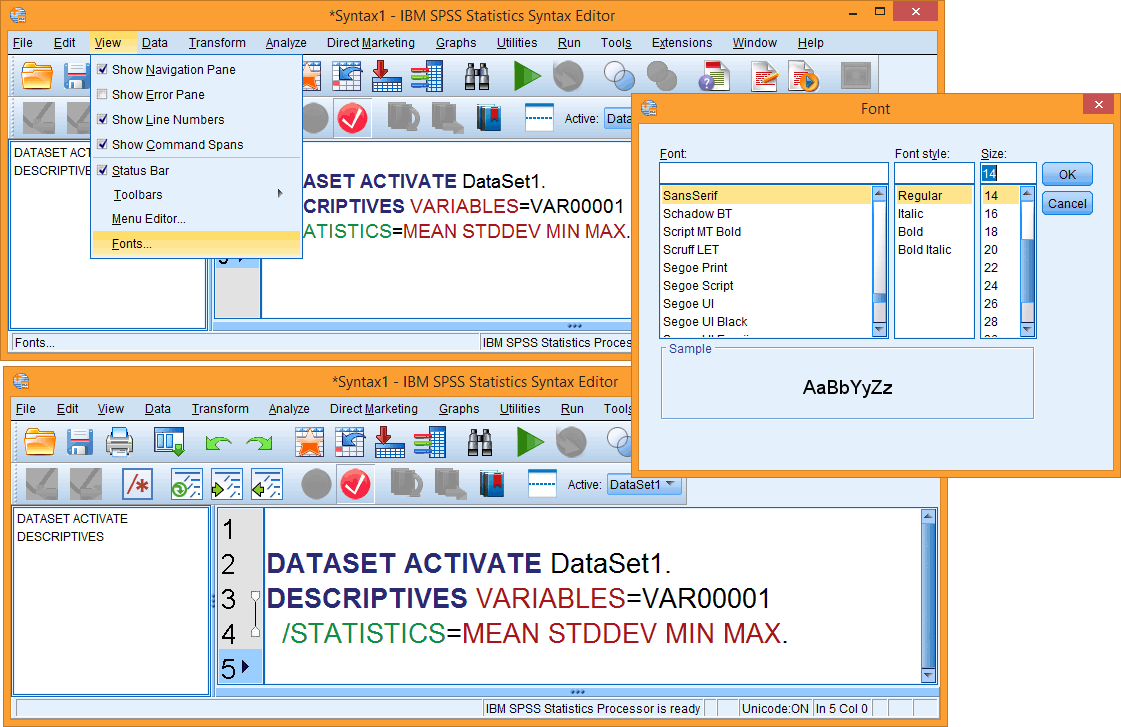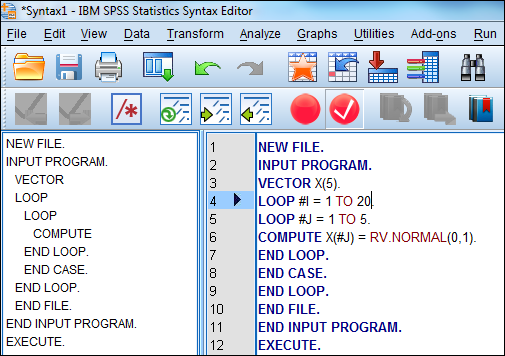

You can see the FORMATS command is followed by the variable names, then the format in parentheses. Here is the command for some common formats: You could go into the Variable View screen and manually change the Width and Decimals columns, which indicate how many characters go before and after (for numeric variables) the decimal point.īut why do all that when you can just use a single command to define multiple variables? The default format is F8.2, which indicates a numerical value So once you create a new variable, you should of course immediately assign a Variable Label, and if appropriate, Value Labels and Missing Data Codes using Synta x.Īnother thing that helps keep your new variable clean and interpretable is to assign the format. (You think you’ll remember now, but 75 new variables later, you’ll thank me).
#SPSS SYNTAX CODE#
This is especially true when you’re creating a LOT of new variables, but even one or two can be quicker if you write the syntax code instead of menus.Īnd just as importantly, you’ll have documentation for exactly how you created them. With SAGE Research Methods, researchers can explore their chosen method across the depth and breadth of content, expanding or refining their search as needed read online, print, or email full-text content utilize suggested related methods and links to related authors from SAGE Research Methods' robust library and unique features and even share their own collections of content through Methods Lists. SAGE Research Methods contains content from over 720 books, dictionaries, encyclopedias, and handbooks, the entire “Little Green Book,” and "Little Blue Book” series, two Major Works collating a selection of journal articles, and specially commissioned videos.One of the places that SPSS syntax excels at efficiency is when you’re creating new variables. Since SAGE Research Methods focuses on methodology rather than disciplines, it can be used across the social sciences, health sciences, and more.



Researchers can explore methods concepts to help them design research projects, understand particular methods or identify a new method, conduct their research, and write up their findings. SAGE Research Methods is a research methods tool created to help researchers, faculty and students with their research projects. SAGE Research Methods links over 175,000 pages of SAGE’s renowned book, journal and reference content with truly advanced search and discovery tools. This book is ideal for all those carrying out quantitative research in the health and social sciences who can benefit from SPSS syntax's capacity to save time, reduce errors and allow a data audit trail. The book is written in such a way as to enable you to pick and choose how much you rely on one method over the other, encouraging you to use them side-by-side, with a gradual increase in use of syntax as your knowledge, skills and confidence develop. This book also supports the use of SPSS syntax alongside the usual button and menu-driven graphical interface (GIF) using the two methods together, in a complementary way. Syntax commands are clearly explained and the value of syntax is demonstrated through examples.
#SPSS SYNTAX HOW TO#
and how to use them throughout the data entry, management and analysis process.Ĭollier covers all aspects of data management from data entry through to data analysis, including managing the errors and the error messages created by SPSS. how to create and manage the SPSS journal and syntax files how to become familiar with the syntax commands Without requiring any knowledge of programming, the text outlines: In this book, Jacqueline Collier introduces the use of syntax to those who have not used it before, or who are taking their first steps in using syntax. SPSS syntax is the command language used by SPSS to carry out all of its commands and functions.


 0 kommentar(er)
0 kommentar(er)
